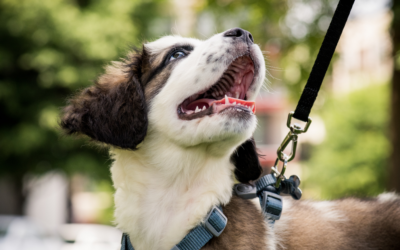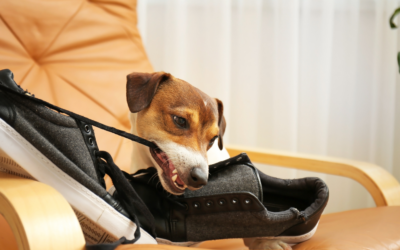Dog anxiety is a common concern among pet owners, and understanding its triggers can help us better support our furry friends. Whether it's caused by environmental factors, social situations, or health-related issues, anxiety in dogs can have a significant impact on their well-being. In this article, we will explore the most common triggers of dog anxiety and how they affect our four-legged companions.
Understanding Dog Anxiety
Anxiety in dogs is not just a result of stress or fear; it is a complex emotional state that various factors can trigger. Anxiety is usually defined as an emotion around the anticipation of something that causes fear.
Recognizing Signs of Anxiety in Dogs
Dogs cannot verbally express their emotions, so it's up to us as responsible pet owners to recognize the signs of anxiety in our furry friends. Some common signs include pacing, panting, trembling, excessive licking, and avoidance of people or certain situations. These signs can appear in anxious animals even when there is a trigger present.
However, it's important to differentiate between normal behavior quirks and anxiety. For example, some dogs may naturally be more reserved or cautious, while others may be more outgoing. By observing and understanding our dogs' unique personalities, we can better identify when anxiety becomes a concern that needs attention.
In addition to the physical signs mentioned earlier, dogs may also exhibit behavioral changes when experiencing anxiety. These changes can include increased aggression, decreased appetite, or even self-harm through excessive scratching or biting. Recognizing these signs is crucial in providing the necessary support and intervention to help our dogs cope with their anxiety.
Moreover, it's worth noting that anxiety in dogs can manifest differently depending on the individual. While some dogs may become hyperactive or restless when anxious, others may become withdrawn and exhibit signs of depression. By being attuned to our dogs' behavior patterns, we can better understand their anxiety and provide appropriate care and treatment.

Environmental Triggers of Dog Anxiety
Our dogs are constantly exposed to their environment, and certain triggers can spark anxiety and fear in their hearts. Identifying these triggers and taking appropriate action can significantly improve our dogs' well-being. Let's explore two environmental triggers that commonly contribute to dog anxiety.
Loud Noises and Phobias
Loud noises, such as thunderstorms or fireworks, can evoke fear and anxiety in dogs. Some dogs develop phobias towards specific sounds, making them tremble and seek shelter to escape their perceived threat. Additionally, sudden and unexpected noises can startle dogs, triggering a response of anxiety or even panic.
To help alleviate noise-induced anxiety, it's essential to create a safe and comfortable space for our dogs when they might encounter loud noises. Providing a designated area where they can retreat, play calming music, or use white noise machines can help reduce their anxiety levels.
For dogs with phobias towards specific sounds, desensitization and counterconditioning techniques are often required. This involves gradually exposing the dog to the sound at a low volume and associating it with something positive. Over time, the volume can slowly be increased, helping the dog build a positive association with the previously feared noise.
Changes in Living Conditions
Dogs thrive on routine and familiarity, so any significant changes in their living conditions can trigger anxiety. Moving to a new home, the arrival of a new family member, or even rearranging furniture can disrupt their sense of security and stability, leading to heightened anxiety.
When faced with changes, we must reassure our dogs and create a consistent routine to help them adjust. Gradual introduction to new environments and positive reinforcement techniques can also aid in reducing anxiety and making them feel more at ease.
Another helpful strategy is to provide our dogs with familiar items from their previous living space. This could include their bed, toys, or even a piece of clothing with our scent on it. These familiar scents can provide comfort and familiarity, helping ease their anxiety during the transition period.
Additionally, engaging our dogs in mental and physical stimulation can help alleviate anxiety caused by changes in living conditions. Regular exercise, interactive toys, and puzzle games can redirect their focus and provide a positive outlet for their energy, reducing stress and promoting a sense of well-being.

Social Triggers of Dog Anxiety
Dogs are social creatures, but certain situations or interactions can cause them to feel anxious and distressed. Understanding these social triggers can help us support our dogs and improve their welfare.
Too Much Alone Time
When it comes to dog anxiety, there are a few key factors that can contribute to their unease. Separation anxiety is an issue that some dogs face. This can manifest when they are left alone or separated from their human companions. Dogs with separation anxiety often exhibit behaviors such as excessive barking, destructive chewing, accidents in the home, and even injury. It's heartbreaking to see our furry friends in such distress, but there are ways we can help them cope.
One effective strategy is to increase their alone time gradually. By starting with short periods and gradually extending the duration, we can help them adjust to being alone. For some, providing interactive toys and puzzles can also keep their minds occupied and alleviate some of their anxiety.
Seeking professional guidance from a veterinarian, animal behaviorist, or trainers that specialize in separation anxiety can provide additional support and advice tailored to your dog's needs. Creating a calm and safe environment can go a long way in helping our dogs feel more secure and reduce their anxiety when left alone.
Fear of Strangers or Other Animals
Another social trigger for dog anxiety is fear of strangers or other animals. Some dogs experience anxiety when faced with unfamiliar people or animals. This fear response can stem from various factors, such as a lack of socialization or past negative experiences. Dogs who are anxious around strangers or other animals may display fearful body language, growling, or even aggression. It's important to address this issue to ensure our dogs feel comfortable and safe in social settings.
It's crucial to expose our dogs to positive and controlled social interactions to address social anxiety through proper training and early socialization. Gradual exposure to new people and animals and positive reinforcement will help our dogs build confidence and reduce their anxiety in social settings.
It's important to remember that every dog is unique, and what works for one may not work for another. Patience, consistency, and understanding are key when helping our furry friends overcome their social triggers and live happier, more relaxed lives.
Health-Related Anxiety Triggers
Just like humans, dogs can experience anxiety as a result of health issues or aging. It's important to know these triggers to ensure our dogs receive the care and support they need during challenging times.
Understanding the specific factors that can trigger anxiety in dogs is essential for providing them with the best possible care and support. By recognizing these triggers early on, pet owners can take proactive steps to help their furry companions navigate difficult periods with comfort and reassurance.
Aging and Anxiety in Dogs
As dogs age, they may become more prone to anxiety. This can be due to a combination of physical discomfort, cognitive decline, and changes in their routine. Some elderly dogs may develop separation anxiety as they become more dependent on their human companions.
It's important for pet owners to approach the aging process with sensitivity and understanding. By creating a calm and secure environment for senior dogs, filled with familiar scents and comforting routines, owners can help alleviate anxiety and promote a sense of safety and well-being in their beloved pets.
Providing extra comfort, maintaining a consistent routine, and incorporating mental stimulation through interactive toys or puzzles can help alleviate anxiety in aging dogs. Additionally, regular veterinary check-ups can identify any underlying health conditions that may contribute to their anxiety.
Illness-Induced Anxiety
Illness or chronic pain can significantly impact a dog's emotional well-being, leading to anxiety and distress. Dogs experiencing discomfort or ailments may exhibit changes in behavior, such as increased restlessness or aggression.
When addressing illness-induced anxiety in dogs, a multi-faceted approach is often necessary. This can involve medical interventions, emotional support, and understanding from pet owners. By creating a nurturing and supportive environment, pet parents can help their dogs feel more secure and at ease during challenging times.
To address illness-induced anxiety, it's crucial to work closely with a veterinarian to develop a comprehensive treatment plan. This may include medications, therapies, or dietary adjustments to manage the underlying health condition and improve the dog's overall quality of life.

How Breed Genetics Influence Anxiety
Beyond external triggers, some dogs are genetically predisposed to anxiety disorders. Understanding these tendencies is crucial to provide appropriate support and care for our furry friends.
The Role of Genetics in Canine Anxiety
Genetics play a significant role in a dog's temperament and personality, including their susceptibility to anxiety. While genetics alone do not determine a dog's behavior, understanding their genetic predispositions can help us better anticipate and manage anxiety-related issues.
By partnering with responsible breeders and incorporating positive training methods that build resilience, we can help dogs overcome genetic-based anxieties and lead happier, more balanced lives.
Dog anxiety is a complex and multifaceted issue, but with the right understanding and support, we can make a positive difference in our dogs' lives. By recognizing the common triggers, addressing their anxiety, and providing a safe and nurturing environment, we can help our furry friends thrive and live anxiety-free.



